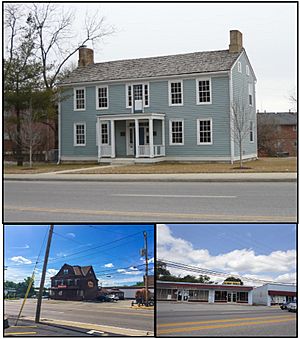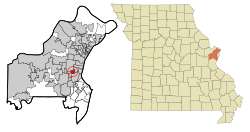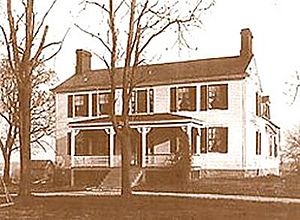Rock Hill, Missouri facts for kids
Quick facts for kids
Rock Hill, Missouri
|
|
|---|---|

Top: The Fairfax House, Bottom Left: Trainwreck Saloon, Bottom Right: Former Rock Hill City Hall
|
|

Location of Rock Hill, Missouri
|
|
| Country | United States |
| State | Missouri |
| County | St. Louis |
| Incorporated as village | April 1929 |
| Incorporated as city | April 1947 |
| Founded by | James Collier Marshall |
| Area | |
| • Total | 1.10 sq mi (2.86 km2) |
| • Land | 1.10 sq mi (2.86 km2) |
| • Water | 0.00 sq mi (0.00 km2) |
| Elevation | 541 ft (165 m) |
| Population
(2020)
|
|
| • Total | 4,750 |
| • Density | 4,306.44/sq mi (1,662.26/km2) |
| Time zone | UTC-6 (Central (CST)) |
| • Summer (DST) | UTC-5 (CDT) |
| ZIP Code |
63119
|
| Area code(s) | 314 |
| FIPS code | 29-62660 |
| GNIS feature ID | 2396399 |
Rock Hill is a suburban town in St. Louis County, Missouri, United States. It's like a neighborhood outside a big city. In 2010, about 4,635 people lived there. Rock Hill is famous for the Fairfax House. This old house is on the National Register of Historic Places.
Contents
Exploring Rock Hill's Location
Rock Hill is a small city, covering about 1.09 square miles (2.86 square kilometers). All of this area is land.
Rock Hill is surrounded by several other cities. These include Ladue, Brentwood, Webster Groves, Glendale, and Warson Woods.
Main Roads in Rock Hill
Manchester Road is a big road in Rock Hill. It has four lanes and goes from east to west. In 2000, people voted to spend $3 million to fix roads. In 2011, they voted again to get $3.5 million more for road repairs.
In 2019, the city decided to lower the speed limit. Now, on most streets, you can only drive 20 miles per hour.
A Look at Rock Hill's Past
Rock Hill's story began around 1832. That's when James Collier Marshall moved there. He and his brother, John Marshall, bought 800 acres of land. They built a log house that was both their home and a store.
In 1839, James built a two-story house. He named it "Fairfax" after a friend. The house was finished a year later. James and his wife, Elizabeth, had five children.
The First Church in Rock Hill
James Marshall wanted to build a church. In 1845, a Presbyterian church group helped him. They built the church on land James gave them. Many people believe that enslaved people built the church. They used stone from a quarry on Marshall's farm. The church was named "Rock Hill Presbyterian Church." This name came from two rocky hills in the area. These hills later gave the town its name.
Mail Service and Trains
James Marshall was the first postmaster around 1845. This means he was in charge of the mail. The post office was at Fairfax House. Later, mail service moved to Webster Groves.
Rock Hill was also a stop for trains. Trains ran twice a day. In 1969, the city decided to take over the train station.
How Rock Hill Grew
For a long time, Rock Hill didn't have many buildings. But in the 1920s, more houses were built. In April 1929, Rock Hill officially became a village. In 1947, it became a city.
In 1959, a strong tornado hit Rock Hill. It caused a lot of damage. In 1965, the city got its own flag.
In 2006, Rock Hill started to focus on retail stores. The city hoped that new shops would help its finances. The city's Fall Festival has been held for many years. The 30th festival was in 2013.
Who Lives in Rock Hill?
The number of people living in Rock Hill has changed over the years. Here's a quick look:
| Historical population | |||
|---|---|---|---|
| Census | Pop. | %± | |
| 1930 | 1,309 | — | |
| 1940 | 1,821 | 39.1% | |
| 1950 | 3,847 | 111.3% | |
| 1960 | 6,523 | 69.6% | |
| 1970 | 6,815 | 4.5% | |
| 1980 | 5,702 | −16.3% | |
| 1990 | 5,217 | −8.5% | |
| 2000 | 4,765 | −8.7% | |
| 2010 | 4,635 | −2.7% | |
| 2020 | 4,750 | 2.5% | |
| U.S. Decennial Census | |||
Population in 2020
In 2020, there were 4,750 people living in Rock Hill.
Population in 2010
In 2010, there were 4,635 people living in Rock Hill. There were 2,064 households, which are groups of people living together. About 26.6% of households had children under 18.
Most people in Rock Hill were White (70.6%). About 23.0% were African American, and 2.5% were Asian. People of Hispanic or Latino background made up 2.8% of the population.
The average age in Rock Hill was 36.9 years old. About 20.7% of residents were under 18. The city had slightly more females (51.0%) than males (49.0%).
Businesses in Rock Hill
Rock Hill has some interesting businesses. The Trainwreck Saloon on Manchester Road has been open since 1890. It's the oldest bar that's been open continuously in St. Louis County.
The Hacienda restaurant building has a long history. It was built in 1861 as a home. In 1951, it became a restaurant. It was one of the first Mexican restaurants in St. Louis.
Over the years, there have been many plans to develop new shopping areas. For example, the Market at McKnight project started in 2004. It aimed to build a large shopping and mixed-use area.
The Book House was a popular bookstore on Manchester Road. It was in a historic Victorian house. In 2013, the bookstore had to move. It reopened in a nearby town called Maplewood in 2014.
Learning in Rock Hill Schools
Since 1948, Rock Hill has been part of the Webster Groves School District. There are two public elementary schools in the city:
- Hudson Elementary School
- Givens Elementary School
Rock Hill used to have its own school district. In 1909, Rock Hill #I school was built. More schools were added later. In 1948, voters decided to join the Webster Groves School District.
Later, a junior high school called Steger Junior High was built in 1960. It was named after a school superintendent. Steger later became an elementary school.
Schall School was rebuilt in 1965. Hudson School closed for a while but reopened in 1984 after being updated.
Rock Hill also had a preschool program. It operated out of the Parks and Recreation building. In 2007, the city decided to stop the preschool program to save money.
Fun Places: Parks and Landmarks
Rock Hill has several parks for people to enjoy. The city started its recreation program in 1971. In 1972, a group was formed to help build a city park. They also started a summer day camp for kids.
By 1982, Rock Hill had five parks:
- Oakhaven Park – This three-acre park has tennis courts, a picnic area, and a playground.
- Oak Trail Nature Park – A four-acre park with walking trails.
- Stroup Field – This park has two softball fields and a soccer/football field.
- Greenwood Park – A smaller park with a basketball court and playground.
These parks cost $325,000 to build. Most of the money came from government programs.
Two more parks have been built since then:
- Hensley Park
- Whitfield Park
A survey in 2009 showed that most residents had visited a city park. They also felt the parks needed improvements. Oakhaven Park was the most popular.
The Historic Rock Hill Presbyterian Church
The Rock Hill Presbyterian Church was built in 1847. It was one of the oldest operating Presbyterian churches west of the Mississippi River. In 2010, the church congregation left the building. In 2011, the property was sold to a gas station company.
In 2012, a winery called Cedar Lake Cellars decided to move the old church building. They moved it to their winery in Foristell, Missouri.
Three time capsules were buried at the church over the years. Two of them were found and opened in 2011. The third one was never found.
Community Groups
Rock Hill has different groups that help the community.
Rock Hill Improvement Association
This group started in 1938. They worked to help the school district and the city. In 1940, they helped create the fire department. In 1943, they helped renovate the Fairfax House to hold a library.
Interested Citizens of Rock Hill Improvement Association
This group was formed in 1963 by Black residents of Rock Hill. They worked to stop businesses from being built in neighborhoods. This group also designed the city's flag in 1965.
See also
 In Spanish: Rock Hill (Misuri) para niños
In Spanish: Rock Hill (Misuri) para niños


